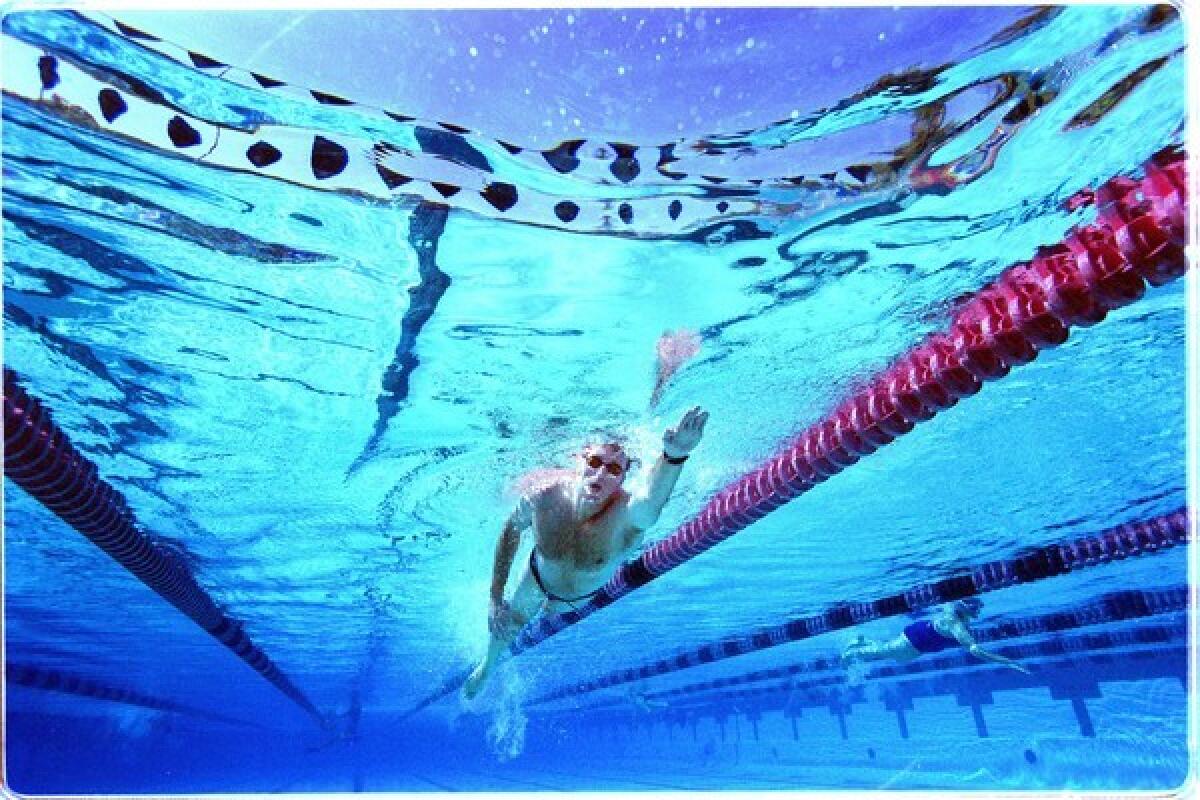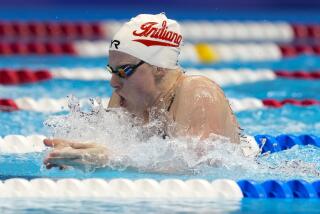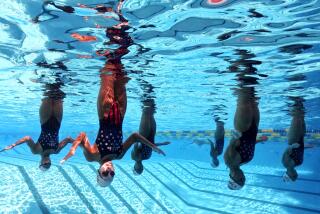New techniques may improve a swimming pool workout

- Share via
Last in a series
Many adults know how to swim -- that is, they can get from one end of the pool to the other without too much trouble. But to swim proficiently and with finesse, they must learn to properly stroke, kick and breathe.
That’s where swim coach Nancy Kirkpatrick-Reno comes in. Head masters coach at Conejo Simi Aquatic Masters and a former masters swimming world champion, Kirkpatrick-Reno has designed a four-week program to quickly improve swimming skills and overall fitness -- with drills and pointers on technique. If you’re stuck in a swimming rut using methods you learned in elementary school, pay attention. “In the last 20 years, the way we swim has become very different,” Kirkpatrick-Reno says, “not to mention the new swimsuits that have taken swimming to whole other levels.”
This last of a four-part series on jump-starting sport-specific workouts begins with choosing the right size pool, and ends with doing copious laps without gasping for air.
Getting started
Before sticking a toe in the water, consider this advice:
* Swim in a pool that’s at least 20 to 25 yards long; those pools can usually be found at high schools and some gyms. A 50-meter Olympic-size pool is best, but not everyone has access to that. “If you’re going to become a lap swimmer,” Kirkpatrick-Reno says, “you can’t go any shorter or you’ll be constantly turning.” An outdoor pool is preferable to an indoor one, because the chlorine and other chemicals dissipate in the air.
* Choose a pool with a pace clock, or get a waterproof swim watch. “It will help you measure how fast you’re swimming,” Kirkpatrick-Reno says. “If you have no clock, how do you know you’re improving?”
* Not all swimsuits are created equal. Racing suits are best, because they cling to the body and cut down on drag, which can slow a swimmer. Men should ditch the loose-fitting trunks or jams -- those, Kirkpatrick-Reno says, “are like taking grocery bags and tying them to your waist” -- and choose a more tight-fitting suit. Don’t worry, tiny suits aren’t the only option; snug swim jammers come almost to the knee (think triathlete gear). Women should choose a sleek racing suit as well; some two-piece options are available. Keep in mind that chlorine may eventually break down the fibers, so wash according to manufacturer’s instructions.
* Swim caps can cut down on drag, especially for people with long hair. They can also protect hair from pool chemicals. Goggles are essential to protect eyes from the same chemicals, and they’re available with prescription lenses and tinting and UV protection for the outdoors.
* A couple of pieces of gear are used during drills: Kickboards can help swimmers focus on kicking properly. And pull buoys (lightweight foam pieces that sit between the thighs, keeping the legs still) make swimmers use more upper body muscles.
* Keep a log to track progress in speed and distance, and note what times of day are best to work out.
* Stay hydrated. Even though you’re in a body of water, you will perspire. Kirkpatrick-Reno suggests keeping water or a sports drink by the side of the pool and taking a few sips during rests.
* Don’t forget to eat after a workout. Swimmers need to replace glycogen levels after exercising, and Kirkpatrick-Reno suggests some combination of carbohydrates and protein, such as a protein bar or chocolate milk.
* Do some cool-down laps after a workout. A few laps at a leisurely pace will help slow the heart rate and cool the body’s core temperature.
Now on to . . .
Week 1
Work out three times a week on nonconsecutive days. Don’t be surprised if you’re winded after just a few laps in the beginning, even if you’re an accomplished runner or cyclist. Swimming uses different muscles and structured breathing and may be taxing at first. But with perseverance, quick improvement is possible. The amount of laps given are suggestions and are for a 25-yard pool, so adjust the number if necessary.
* Drills begin with streamlining off the wall. Begin with feet against the wall, and drop just under the surface of the water. Push off the wall in a streamlined position: Hands are directly in front of head, one over the other, and upper arms are tucked next to the ears. Toes are pointed. When you begin to slow down, kick a little and come to the surface. “It’s like you’re an arrow cutting through the water,” Kirkpatrick-Reno says. “This gets you used to the feeling of going through the water, and in swimming, you want to be streamlined. You want to get your body to a point.” Stop and return to the wall, or swim the rest of the length of the pool and begin again. Repeat 10 times.
* Next, swim using one arm across one length of the pool. Keep the left arm outstretched in front, right arm by your side, close to your hip. Eyes are facing the bottom of the pool and the legs are flutter kicking. To do that, keep heels in the water and kick from the hips, not the knees. Point the toes. Don’t let the legs drag down in the water and make large kicks -- this isn’t like snorkeling. To stroke, lean slightly to the left, with the right shoulder back, bring the right arm up, and stroke into the water, using the arm from the fingertip to the elbow as a paddle. Use only the right arm to go across the pool, then switch to the left arm on the next lap. Repeat, changing arms each lap, for four to eight lengths. If possible, breathe every few strokes, or as often as you need to. When breathing, rotate the head out of the water to the side, don’t lift it up.
* The catch-up drill begins with the left arm in front and the right arm by your side. Bring your right arm around to meet the left, then stroke with the left arm, bringing it around to meet the right. The arms “catch up” to each other instead of continuously paddling through the water. Repeat four to eight lengths, breathing every couple of strokes if possible, or more often if necessary.
* Flutter kick for 200 yards while holding a kickboard. Keep your hands over the far edge of the board and your head above water and do flutter kicks.
* Do a freestyle swim for 200 yards at an 85% effort, using stroking, breathing and kicking techniques used in the previous drills.
Week 2
Repeat the drills from Week 1.
This week adds a kicking drill, which develops leg muscles, works on breathing, and improves the cardiovascular system.
* Begin with one arm extended in front, the other arm by your side, shoulder back. Kick six times, then bring the right arm around so that both arms are in front, kicking six times again. Next, stroke with the left arm, kicking six times, and take a breath. Breathe more frequently through the cycle if necessary. Repeat for 200 yards.
* Next, do two 200-yard lengths of freestyle, taking a 20-second rest between sets.
* Then do six 100-yard lengths, taking a 20-second rest between sets. Focus on your stroke technique.
Week 3
Although counting laps and focusing on proper technique can be distracting, monotony can set in. Kirkpatrick-Reno suggests combating it by talking to lane mates during rests, using a waterproof MP3 player, or letting your mind wander a bit.
* Warm up with a combination of drills from Week 1 for 400 to 600 yards.
* To get the heart rate up, swim six 25-yard lengths at about a 75% to 80% effort.
* Rest for a minute and do the main swimming set, consisting of eight 75-yard lengths; in a 25-yard pool, do one lap freestyle, one backstroke or breast stroke, and one freestyle. Or, do all three laps freestyle, increasing intensity with each lap. Do the first lap at a 70% effort, the second at 75% and the third at 80%. Take a 15-second rest between sets. This helps build endurance and speed.
* Swim four 100-yard lengths with the pull buoy, which isolates upper body muscles. Try to breathe every third stroke.
Remember to do a few cool-down laps.
Week 4
Warm up with 400 to 600 yards of drills from Week 1, including swimming four 50-yard lengths with a 15-second rest between sets.
* The main swimming set begins with swimming 300 yards, then 200 yards, then 100 yards, with a 20-second rest between each set. Using the pull buoy, swim 100 yards, then 200 yards, then 300 yards, again with rests between sets. This “ladder swim” builds endurance.
Cool down with some easy laps.
Although your conditioning has no doubt improved, Kirkpatrick-Reno says swimmers benefit from strength training, best done on nonswimming days. Exercises that work the thighs, shoulders, arms, core and back are especially important. Include exercises such as squats, lunges, seated rows, crunches and other abdominal work, and planks. Work on ankle flexibility too, to make them less stiff.
After four weeks, you may need the help of a coach to perfect your technique and speed. Some workout tips and training plans can also be found in books and online. Joining a masters program or a local swimming group offers instruction, and opportunities to socialize with other swimmers.
For more information on local masters swimming programs, go to U.S. Masters Swimming ( www.usms.org).






